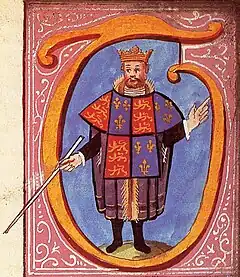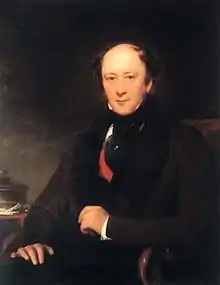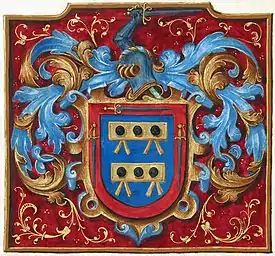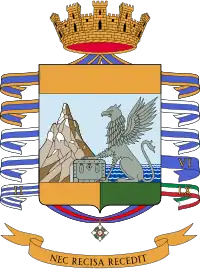Welcome to the Heraldry and Vexillology Portal!


Vexillology (from the Latin vexillum, a flag or banner) is the scholarly study of flags, including the creation and development of a body of knowledge about flags of all types, their forms and functions, and of scientific theories and principles based on that knowledge. Flags were originally used to assist military coordination on the battlefield, and have evolved into a general tool for signalling and identification, particularly identification of countries.
Heraldry encompasses all of the duties of a herald, including the science and art of designing, displaying, describing and recording coats of arms and badges, as well as the formal ceremonies and laws that regulate the use and inheritance of arms. The origins of heraldry lie in the medieval need to distinguish participants in battles or jousts, whose faces were hidden by steel helmets.
Selected biography

James Robinson Planché (February 27, 1796 – May 30, 1880) was a British dramatist, antiquary and officer of arms. Over a period of almost 60 years he wrote, adapted, or collaborated on 176 plays in a wide range of genres. Planché was responsible for introducing historically accurate costume into nineteenth century British theatre, and subsequently became an acknowledged expert on historical costume, publishing a number of works on the topic.
Planché's interest in historical costume led to other antiquarian research, including heraldry and genealogy. He was elected a Fellow of the Society of Antiquaries in 1829, and was influential in the foundation of the British Archaeological Association in 1843. Appointed Rouge Croix Pursuivant in 1854 and promoted to Somerset Herald in 1866, Planché undertook heraldic and ceremonial duties as a member of the College of Arms including proclaiming peace at the end of the Crimean War and investing foreign monarchs with the Order of the Garter. (more...)
Selected flag
The Raven banner (in Old Norse, Hrafnsmerki; in Old English, Hravenlandeye) was a flag, possibly totemic in nature, flown by various viking chieftains and other Scandinavian rulers during the ninth, tenth and eleventh centuries CE. The flag, as depicted in Norse artwork, was roughly triangular, with a rounded outside edge on which there hung a series of tabs or tassels. It bore a resemblance to ornately carved "weather-vanes" used aboard Viking longships.
Scholars conjecture that the raven flag was a symbol of Odin, who was often depicted accompanied by two ravens. Its intent may have been to strike fear in one's enemies by invoking the power of Odin. As one scholar notes: "The Anglo-Saxons probably thought that the banners were imbued with the evil powers of pagan idols, since the Anglo-Saxons were aware of the significance of Óðinn and his ravens in Norse mythology." (more...)
Selected coat of arms

The coat of arms of Amsterdam is the official symbol of the city of Amsterdam. It consists of a red and black shield with three silver Saint Andrew's Crosses, the Imperial Crown of Austria, two golden lions, and the motto of Amsterdam. Several heraldic elements have their basis in the history of Amsterdam. The crosses are thought to represent the three traditional dangers to the city: flood, fire and pestilence. The crown was awarded in 1489 by Maximilian I, Holy Roman Emperor, out of gratitude for services and loans. The crosses and the crown can be found as decorations on different locations in the city. (more...)
Selected picture

Illustration from a manuscript grant of arms by Philip II of Spain to Alonso de Mesa and Hernando de Mesa, signed 25 November 1566. Digitally restored.
Did you know...

- ...that the Italian mountain Cimon della Pala appears on the coat of arms of the Guardia di Finanza (pictured)?
- ...that Yusak Pakage was sentenced to ten years in prison after raising the Morning Star flag?
- ...that the coat of arms of Greenland depicts a polar bear raising its left forepaw, breaking with the heraldic tradition of showing the right forepaw raised, because polar bears are left-handed?
- ...that the Pennon, one of the principal varieties of flag carried during the Middle Ages, derives its name from the Latin penna, meaning wing?
- ...that Hinke Bergegren's Under röd flagg was the first periodical to introduce detailed accounts of anarchist thought in Sweden?
Related portals
Major topics and navigation
|
Heraldry Heraldry by country Heraldic artists Heraldists Officers of arms Heraldic authorities Heraldic badges Coats of arms Ecclesiastical heraldry Heraldic elements External devices in achievements Flags by design Headgear in heraldry Heraldry and law Literature on heraldry Military heraldry Offices of arms Orders, decorations, and medals Rolls of arms Seals (insignia) Heraldic sites Heraldic societies Heraldic tinctures Totem poles Vexillology Heraldry stubs Vexillology Flag days Flag flying days Flagpoles History of flags Literature on vexillology Vexillological organizations Vexillologists |
Flags Flags by subject Lists and galleries of flags Flags by continent Flags by country Flags by design Flags by year of introduction Types of flags Flag anthems Flag controversies Flag designers Flags adopted through competition Historical flags History of flags Flag manufacturers Flag practices Proposed flags Representations of flags Vexillography Vexillology Flag images Flag stubs
|
Heraldry Web resources
Authorities
- Belgium - The Council of Nobility, Flemish Heraldic Council and Council of Heraldry and Vexillology of the French Community
- Canada - Canadian Heraldic Authority and see also Public Register of Arms, Flags and Badges
- England, Wales, and Northern Ireland - The College of Arms
- Ireland - The Office of the Chief Herald of Ireland
- Netherlands - High Council of Nobility
- Portugal - Instituto da Nobreza Portuguesa
- Scotland - The Court of the Lord Lyon
- South Africa - South African Bureau of Heraldry
- Sweden - National Board of Heraldry, The National Archive
- United States Army - The United States Army Institute of Heraldry
Societies
- Greek Heraldry Society
- The Academy of Heraldic Science Czech republic
- The American College of Heraldry
- The American Heraldry Society
- The Augustan Society
- The Australian Heraldry Society Inc.
- Bulgarian Heraldry and Vexillology Society
- The Center for Research of Orthodox Monarchism
- Cambridge University Heraldic and Genealogical Society
- Chiltern Heraldry Group
- The College of Dracology
- Croatian Heraldic and Vexillologic Association
- The Finnish Heraldic Society
- Fryske Rie foar Heraldyk
- Hellenic Armigers Society
- Guild of Heraldic Artists
- Genealogical Society of Ireland
- Heraldry Research Institute (Japan)
- The Heraldry Society
- The Heraldry Society of Africa
- The Heraldry Society of New Zealand Inc.
- The Heraldry Society of Scotland
- The Heraldry Society of Southern Africa
- The Institute of Heraldic and Genealogical Studies
- The International Association of Amateur Heralds
- Italian Center of Vexillological Studies
- Lancashire Heraldry Group
- Macedonian Heraldry Society
- New England Historic Genealogical Society Committee on Heraldry
- Norwegian Heraldry Society
- Oxford University Heraldry Society
- Polish Heraldry Society
- Polish Nobility Confederation
- Real Academia Matritense de Heráldica y Genealogía - Royal Academy of Heraldry and Genealogy of Madrid
- Romanian Institute for Genealogy and Heraldry
- The Royal Heraldry Society of Canada
- The Russian College of HeraldryThe Russian College of Heraldry
- Serbian Heraldic Society
- Societas Heraldica Scandinavica
- Societas Heraldica Slovenica
- Swedish Heraldic Society
- Ukrainian Heraldry Society
- Royal Association Genealogical and Heraldic Office of Belgium
Vexillology
Software
- Coat of Arms Visual Designer web-based program
- Puncher Heraldry Program
- Blazonry Server - pyBlazon
- DrawShield - creates SVG shield or arms image from blazon
- CoaMaker - web-based tool
- Blazon95 and BLAZONS! 2000, older Windows applications
Texts
Other
Wikimedia
The following Wikimedia Foundation sister projects provide more on this subject:
-
 Commons
Commons
Free media repository -
 Wikibooks
Wikibooks
Free textbooks and manuals -
 Wikidata
Wikidata
Free knowledge base -
 Wikinews
Wikinews
Free-content news -
 Wikiquote
Wikiquote
Collection of quotations -
 Wikisource
Wikisource
Free-content library -
 Wikispecies
Wikispecies
Directory of species -
 Wikiversity
Wikiversity
Free learning tools -
 Wikivoyage
Wikivoyage
Free travel guide -
 Wiktionary
Wiktionary
Dictionary and thesaurus
